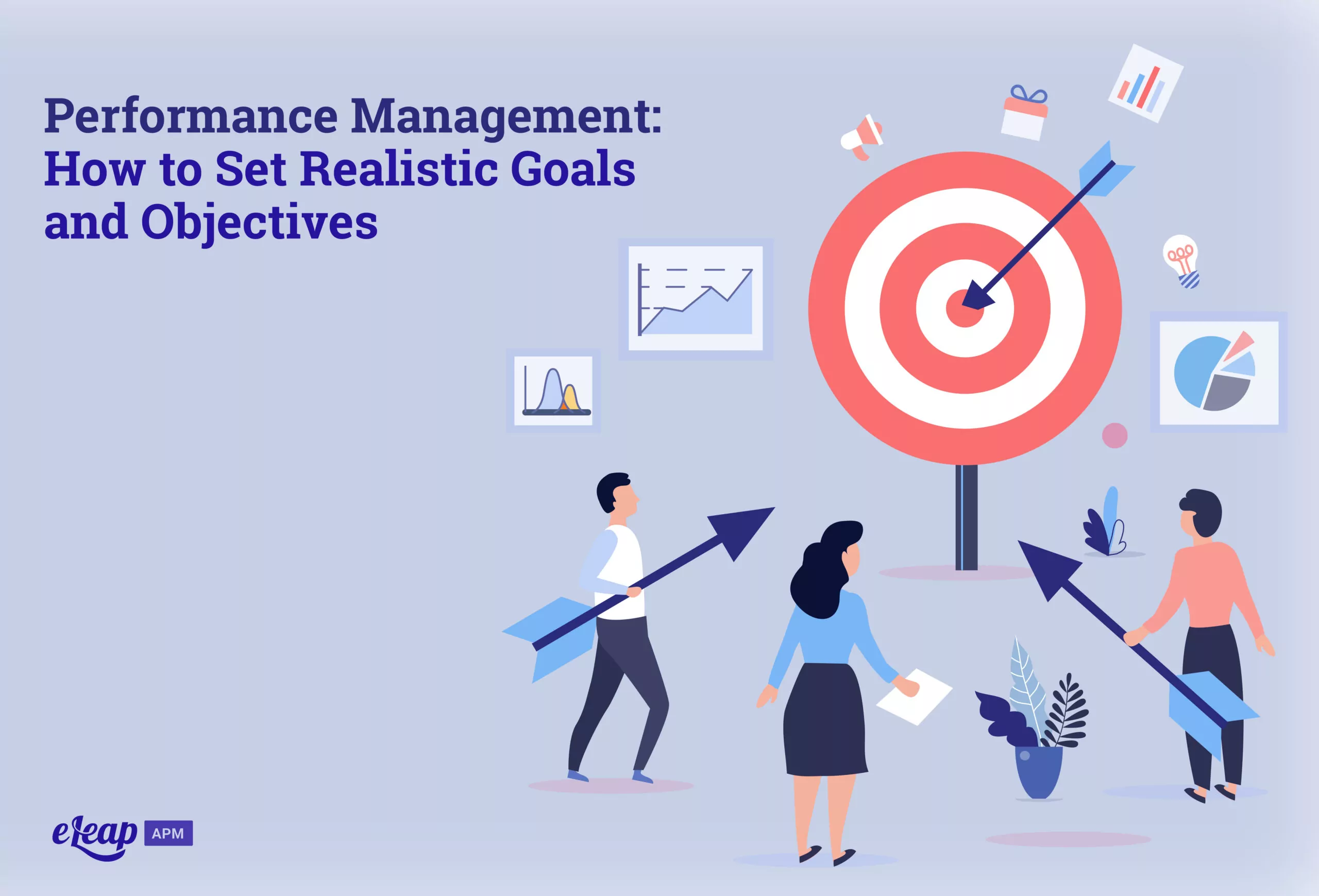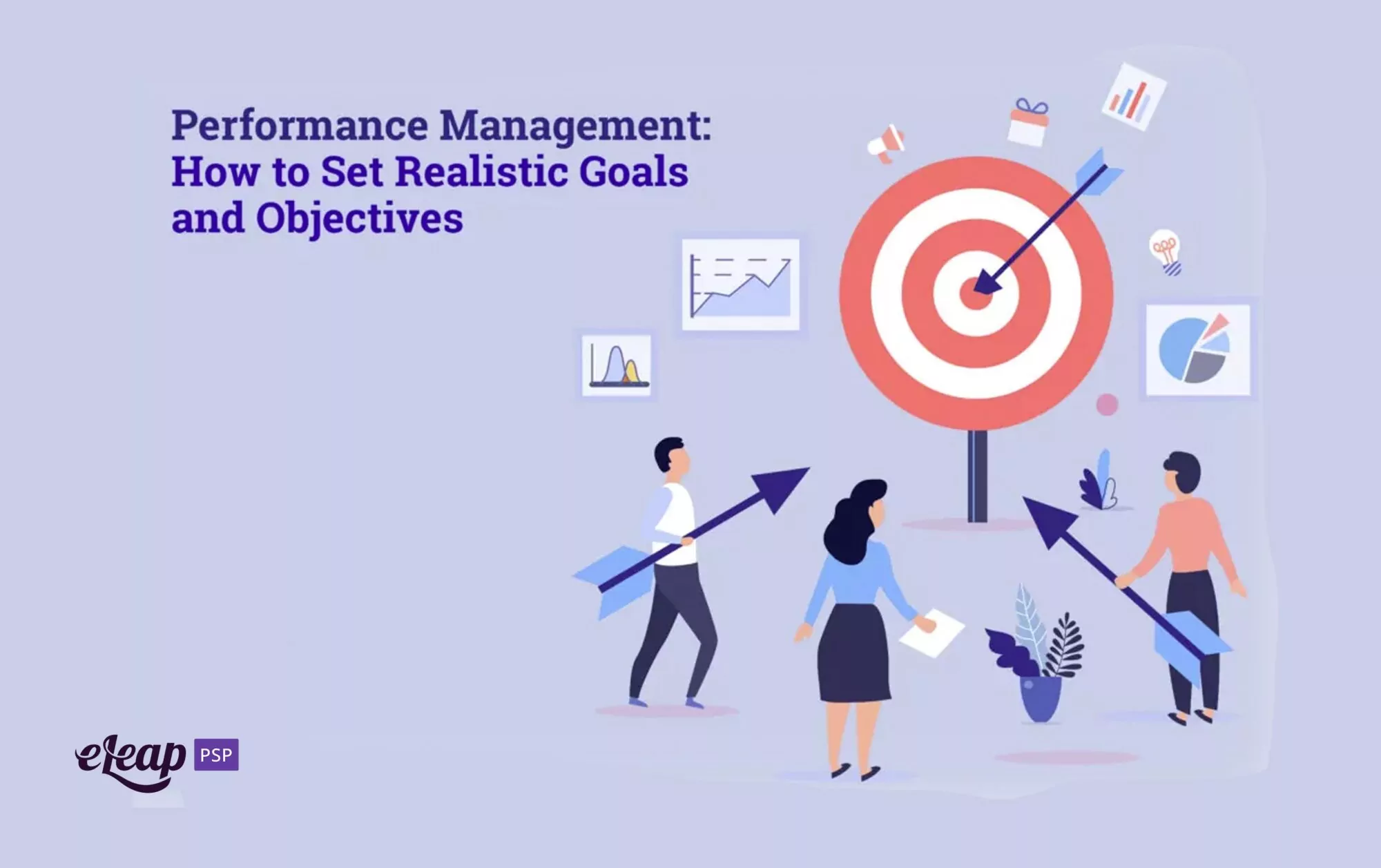Performance Management: How to Set Realistic Goals and Objectives

Motivating employees is the point of performance management. With improved motivation, employees perform better, and your organization moves closer to reaching its objectives. However, telling your employees that they need to do better is not enough. They need more than just criticism. They need support, and it’s your job to deliver that through realistic goals and objectives for performance improvement. How do you set those, though? We’ll explore what you need to know below. Explore how eLeaP’s Performance Management Platform can simplify evaluations, boost productivity, and drive measurable results.

Performance Goals versus Development Goals
The line between learning and development and performance management continues to blur. Nowhere is that clearer in the confusion over performance goals and development goals. After all, they’re pretty similar, so what actually sets one apart from the other?
Simply put, development goals are what employees work to become, while performance goals are what employees work to achieve. Performance goals are based on the goals of the organization as a whole rather than the employee’s career path.
For instance, a performance goal might be to “implement a billing management system within the accounting department” with a hard end date. In comparison, a development goal might be “improving accounting skills and advancing to a higher position within the department.”
Both performance and development goals are important, but they are not the same. Management must understand the difference to set accurate goals for professional development and employee performance.
The Benefits of Goal Setting
Before we dive into the how of the situation, it’s important to address why goal setting is important. What benefits can it offer? Here are just a few:
- They guide employee performance.
- They help focus on achieving successful outcomes.
- They help deepen employee engagement.
- They can help strengthen the business.
- They can help build the business’s reputation as an employer of choice.
With that out of the way, let’s discuss what goes into creating goals and objectives that motivate, empower, and foster success.
Take a Cue from Company Objectives
The first thing you need to consider when setting employee performance goals is the connection to company goals and objectives. Take an overall company goal and then cut it into smaller pieces that apply to individual departments. Then, take that department goal and decide how the individual in question fits into the equation. Base their performance goals on that and ensure that they understand how they’re helping the company achieve broader goals.
Involve the Employees
Often, goals are more motivating when they mean something personally. For instance, you’re more likely to start jogging and then continue to jog over time if you want to improve your health and value how jogging makes you feel. However, if you place little value in those things but are forced to jog by circumstances, you’re not going to perform as well and will likely stop eventually, no matter what the health benefits might be.
So, involve your employees in the goal-setting process. Ask them what goals they feel they should pursue. Find out what objectives matter to them. Make sure that those goals align with the overall business strategy, but if they do, incorporate them into the performance plan.
Use the SMART Method
The SMART method is widely used in all industries today. It stands for specific, measurable, attainable, realistic, and time-bound. Every goal and objective you set should fall within those boundaries. If it is not specific, measurable, attainable, realistic, and/or time-bound, then it becomes harder or even impossible to achieve the goal.
Relevance
While the SMART system does a lot to help set realistic goals, it does not touch on one thing: relevance. The goal should be relevant. To what, you ask? It should be relevant to several things, including the following:
- Position – All goals should be relevant to the employee’s position within the organization. If they are not relevant, they lack value (at least to the employee). They can even become demotivating and a source of frustration.
- Skills – Asking employees to reach a goal they aren’t skilled for is asking for the unlikely at best and the impossible at worst. You would never ask a chef to build you a custom cabinet, would you? Treat your employees the same way. However, realize that this is also an opportunity to offer upskilling and professional development. If you have a need within the organization but lack a team member with the required skills, it’s time to train someone and promote from within.
- Department – The goal must also be relevant to the department within the organization. Despite modern trends, much information remains siloed within departments, making cross-department projects difficult to achieve. If you need to reach a goal that spans more than one department, consider creating a team to handle it instead of assigning it to a single individual from one department or the other.
Make Sure Goals Are Attainable
Attainability is one of the SMART metrics, but it bears further scrutiny. Mostly, this is because goals should challenge your employees and make them reach beyond their comfort zones. However, they cannot be so challenging that they are no longer attainable. One way to do this is to set a goal but then set stretch targets. If you’re familiar with how crowdfunding works with stretch goals, it’s very similar.
This is how it works. Let’s say you set a goal to increase productivity by 5% within 30 days. If the employee can meet that goal, then a stretch target might be to increase productivity by another .1% each week for a specified period. Note that there should be no negative repercussions for not reaching stretch targets, but something positive should be tied to achieving them.
Conclusion
Ultimately, setting realistic goals and objectives may not be rocket science, but it does require an informed approach and in-depth knowledge about the business, the department, and the individual employee. The right goals can motivate, challenge, and foster growth. The wrong goals can demotivate and frustrate. Managing goals and objectives and making sure they are properly aligned might require a system. Feel free to try eLeaP for 30 days and see how the system can help you create and keep goals and objectives aligned.